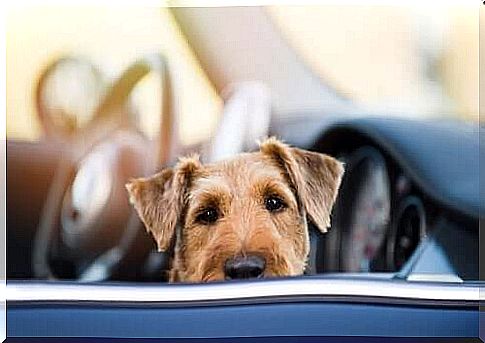Consequences Of Leaving A Dog Alone In The Car

Leaving a dog in the car alone can be very dangerous. Many people who don’t give this topic the attention it deserves may underestimate the effects of this act, which can be deadly. Next, we want to talk in detail about the consequences of leaving your dog in the car alone.
What happens when a dog is alone in the car?
Sometimes we don’t want to be separated from our dogs, or we simply want to take advantage of the time we’re going to devote to commitments to take them for a walk. Well, if you are one of those people who leave the dog in the car, stop it! This act can even kill your pet.
To demonstrate this fact, a veterinarian locked himself in a car on a sunny day to make it clear what happens when the dog is inside.
This is Dr. Ernie Ward. He wanted to show that if we suffered the consequences of an act like that, having a larger body size and possibly a greater adaptability to adverse circumstances, then we could get an idea of what a small dog could go through.
After five minutes inside the car, its interior had reached 37°C, although he left the windows open a few inches. Five minutes later, the vet stated that he was seeing everything blurry outside, as if things were moving.
He started to get dizzy as the heat took over. Sweat also began to show on his clothes.

After 20 minutes, it was 43°C and the vet was just thinking about getting out of there. But it was all for a good cause, so he had to resist to demonstrate the effects of this cruel act that is beginning to be considered a kind of animal abuse and punishable by law.
What happens to dogs in this situation?
After reaching 44°C, the doctor emerged from the vehicle dizzy and dehydrated and explained his conclusions. As a human, he was able to externalize the heat through sweat, which served to regulate his body temperature a little, but dogs don’t have this ability because they don’t sweat.
A dog will show heat distress with these symptoms: lethargy, excess salivation, restlessness, intense thirst, wheezing, fast heart rate, vomiting, fever, diarrhea, dark tongue, and even lack of appetite.
Both this experiment and other studies carried out have shown that a dog that is locked in a car can suffer not only physical damage, but also mental and emotional damage.

These are some of them:
- Feeling of abandonment. That will be the first thought that will cross a dog’s mind: that you have abandoned him to his own devices.
- Stress. Soon after the feeling of abandonment, the dog will start to get nervous and stressed, which will put him in a situation that could cause brain damage.
- Dehydration. Think that a car under the sun will turn into a kind of greenhouse, that is, your dog will start to have a thirst that he will not be able to quench because there is no water or because it is hot, and will start to show other symptoms.
- Loss of consciousness. Once the heat has reached a point that the dog can no longer stand, he will start to feel dizzy, and if you don’t get him out of there in time, he may lose consciousness. Adding the latter to the previous symptoms, if you don’t pay attention to him quickly, he may even die.
Not long ago, there was a case in Spain of a man who left his pit bull in a closed car in the sun. The animal knocked on the windows when it saw people passing by as if asking them to be taken away.
People called the Civil Guard, who arrived and broke the car’s windows to get the animal out and serve it.
The poor dog was so thirsty that it looked like he had never had water in his life. As a result of this cruel act, the owner was denounced and lost custody of the animal.
We are happy to know that justice judges those who mistreated animals, even though we still have a long way to go.









